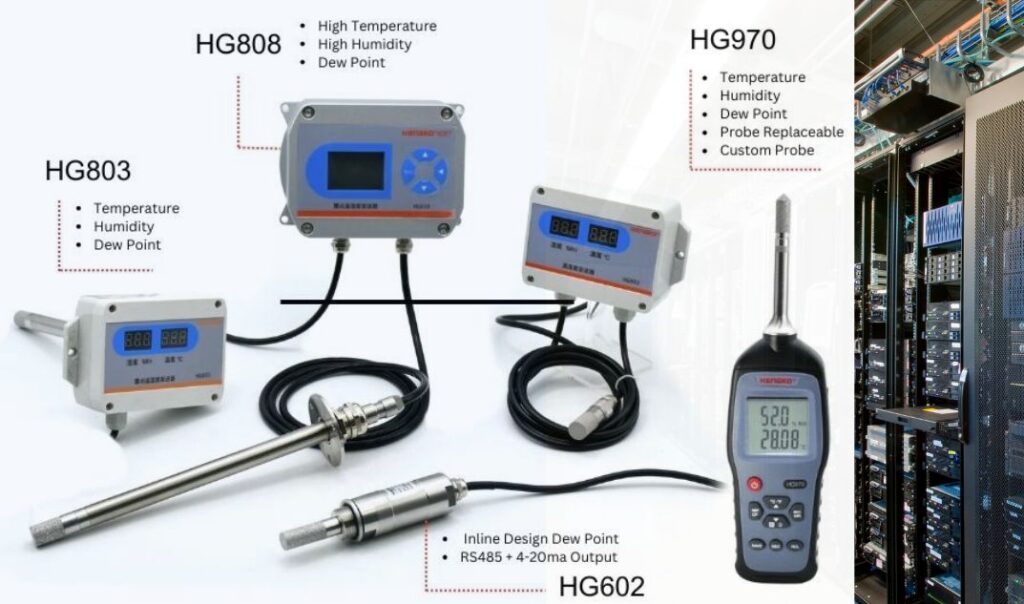Optimizing Your Server Room Environment
In today’s digital age, businesses rely heavily on their data and the servers that store and process it.
Server rooms are the heart of this critical infrastructure, and maintaining optimal environmental conditions within them is essential for ensuring smooth operations, preventing equipment failure, and maximizing server lifespan.
This presentation will explore the importance of creating an ideal environment for your server room and delve into the concept of dew point, a crucial factor for preventing moisture-related problems.
Why Optimal Conditions Matter
There are many benefits if you can maintain a good server working environment, and here we list some important for you.
- Server performance: Excessive heat can lead to overheating, causing servers to throttle back performance or even shut down completely.
- Equipment lifespan: Heat and humidity stress components, shortening their lifespan and increasing the risk of hardware failure.
- Energy consumption: Inefficient cooling systems due to improper temperature and humidity control lead to higher energy bills.
- Downtime costs: Server outages caused by environmental issues can result in significant downtime costs for businesses.
Humidity and Dew Point: Crucial Factors in Server Room Environment
While humidity is certainly an important aspect of server room conditions, dew point is a more critical metric for assessing moisture risks.
Dew point, as mentioned, is the temperature at which water vapor in the air condenses into liquid water. It’s influenced by both temperature and humidity levels.
- Titik embun is the temperature at which water vapor in the air condenses into liquid water.
- It is influenced by both temperature and humidity.
- High humidity and low temperature create a lower dew point, increasing the risk of condensation on server components.

Memahami Titik Embun
Dew Point Definition:
Definition:
Dew point is the temperature at which the air becomes saturated with moisture, causing water vapor to condense into liquid water droplets.
Think of it like this:
Imagine a glass of ice water on a hot, humid day. As the warm, moist air comes into contact with the cold glass, the air cools down. Eventually, the air reaches a point where it can no longer hold all the moisture it contains, and water droplets form on the outside of the glass. The temperature of the glass at this point is the dew point.
Dew Point vs. Relative Humidity:
*Relative Humidity:
This is a measure of how much moisture is currently in the air compared to the maximum amount it can hold at that temperature. It’s expressed as a percentage.
Key Difference:
Relative humidity tells you how much moisture is present, while dew point tells you the temperature at which condensation becomes a risk. High humidity can exist at high temperatures without condensation, but once the air cools to the dew point, condensation occurs.
Why Dew Point Matters in Server Rooms:
*Condensation Threat: Server rooms are filled with sensitive electronic equipment. When the air temperature in the server room falls to the dew point, condensation can form on these components. This moisture can lead to:
– Corrosion: Over time, condensation can cause metal components to rust and degrade.
– Electrical Shorts: Water droplets can bridge electrical connections, causing short circuits and equipment failure.
– Reduced Efficiency: Condensation can also insulate components, leading to overheating and reduced performance.
Therefore, monitoring dew point is crucial for maintaining a safe and healthy environment for your server equipment.
By keeping the dew point within a safe range, you can prevent condensation and ensure the smooth operation of your servers.
Impact of Dew Point on Server Room Operations
Walking the Tightrope: Balancing Dew Point for Optimal Performance
Maintaining a proper dew point is essential for server room operations. Both high and low dew points can pose significant risks to your equipment.
High Dew Point:
*Consequences of Condensation:
As we discussed earlier, high dew points create a greater risk of condensation. This moisture can lead to:
*Corrosion:
Over time, water droplets can cause metal components to rust and degrade, leading to malfunctions and equipment failure.
*Electrical Shorts:
Water droplets bridging electrical connections can cause short circuits, damaging delicate server components and potentially causing data loss.
*Reduced Efficiency:
Condensation can act as an insulator, trapping heat around sensitive components. This can lead to overheating, reduced performance, and increased energy consumption by the cooling system trying to compensate.
Low Dew Point:
*Static Electricity Buildup:
Extremely low dew point environments can lead to excessive static electricity buildup in the air.
This static discharge can damage sensitive electronic components when personnel come into contact with equipment.
While this might not be a daily concern, it becomes a risk factor during maintenance or upgrades when technicians need to interact with the servers directly.
*Finding the Sweet Spot:
By maintaining a dew point within a recommended range (typically between 41°F and 55°F or 5°C and 13°C), you can minimize the risk of both condensation
and static electricity buildup. This helps to ensure the smooth operation, longevity, and optimal performance of your server equipment.

Monitoring Dew Point in Server Rooms
Why Continuous Monitoring Matters:
Dew point is a dynamic variable that can fluctuate throughout the day depending on factors like ambient temperature and external humidity.
Therefore, simply taking occasional spot measurements isn’t enough. Here’s why continuous monitoring is crucial:
*Proactive Prevention:
By monitoring dew point continuously, you can identify potential problems before condensation occurs.
This allows you to take timely corrective actions, such as adjusting the temperature or humidity levels in the server room.
*Early Detection:
Early warning of rising dew point allows you to implement preventive measures before condensation
forms and damages equipment.
*Data-Driven Decisions:
Continuous monitoring provides valuable data on dew point trends over time.
This data can be used to optimize your server room’s environmental controls and ensure long-term equipment health.
Types of Dew Point Monitors:
There are two main types of dew point monitors for server rooms:
These are handheld devices that allow you to take spot measurements at various locations within the server room.
They are a good option for initial setup or troubleshooting specific areas.
*Fixed Dew Point Transmitter Monitors:
These are permanently installed devices that continuously monitor dew point and other environmental factors(temperature, humidity)
within the server room. They often come with alarm features that can notify you if dew point levels reach critical thresholds.
Choosing the Right Monitor:
When selecting a dew point monitor, consider these features:
*Accuracy and Reliability:
Ensure the monitor provides accurate dew point readings to make informed decisions.
*Data Logging and Alerting:
Choose a monitor that can log dew point data over time and send alerts when pre-set thresholds are exceeded.
*Remote Monitoring Capabilities:
Consider models that allow you to monitor dew point remotely for added convenience and faster response times.
*Ease of Use:
The monitor should be easy to install, operate, and maintain.
By implementing a continuous dew point monitoring system, you gain valuable insights into your server room’s environment
and can proactively address potential moisture issues, ultimately safeguarding your equipment and ensuring optimal server performance.
Ideal Dew Point Levels for Server Rooms
The Safe Zone:
Maintaining a proper dew point range is crucial for preventing both condensation and static electricity. The recommended dew point range for server rooms typically falls between 41°F and 55°F (or 5°C and 13°C). This range helps to minimize the risk of moisture-related problems while also keeping static discharge under control.
It’s Not a One-Size-Fits-All Solution:
However, the ideal dew point for your specific server room can vary slightly depending on a couple of factors:
*Geographic Location:
Humidity levels can differ significantly depending on your climate.
For example, server rooms in naturally more humid regions may need to maintain
a slightly lower dew point to avoid condensation concerns.
*Server Room Design and Insulation:
The effectiveness of your server room’s cooling system and the level of insulation will also influence the optimal dew point.
A well-insulated server room with a robust cooling system may have some flexibility in its dew point range compared to a less insulated space.
Finding Your Sweet Spot:
Consulting with an HVAC professional specializing in data center environments can be helpful in determining the ideal dew point range
for your specific server room.
They can consider factors like your location, cooling system, and server load to provide tailored recommendations. By maintaining the
appropriate dew point within this recommended range, you can create a safe and healthy environment for your server equipment.
Solutions for Managing Dew Point
Maintaining the ideal dew point in your server room requires a multi-pronged approach. Here are some key strategies to consider:
1. HVAC Systems: The First Line of Defense:
*Your HVAC system plays a crucial role in controlling both temperature and humidity, which directly impact dew point.
*Ensure your HVAC system is properly sized for the server room’s heat load. An undersized system will struggle to maintain
the desired temperature and humidity levels.
*Regularly schedule preventative maintenance for your HVAC system to ensure it’s operating efficiently.
*Consider advanced HVAC features like dew point control systems that can automatically adjust cooling processes to manage moisture levels.
2. Dehumidifiers and Humidifiers: Fine-Tuning the Environment:
*Dehumidifiers:
In high-humidity environments, dehumidifiers can be used to remove excess moisture from the air,
lowering the dew point and preventing condensation.
*Humidifiers:
In extremely dry climates, humidifiers may be necessary to maintain a minimum level of humidity and prevent static
electricity buildup. However, use them cautiously, as over-humidification can lead to condensation problems.
3. Sealing the Deal: Insulation and Airflow Management:
*Proper Insulation:
A well-insulated server room minimizes the infiltration of hot and humid outside air, making it easier for the HVAC system to maintain a stable temperature and dew point.
*Sealing Air Leaks:
Identify and seal any air leaks in the server room to prevent unconditioned outside air from entering and disrupting the controlled environment.
*Optimizing Airflow:
Ensure proper airflow within the server room. Hot spots can create microclimates with higher dew points, so proper airflow distribution is crucial.
4. Vigilance is Key: Monitoring and Maintenance
*Continuous Monitoring:
As discussed earlier, continuous dew point monitoring is essential. Regularly review data to identify trends and potential issues.
*Calibration of Equipment:
Regularly calibrate your dew point monitors and other environmental sensors to ensure they provide accurate readings.
*Preventative Maintenance Schedule:
Schedule regular maintenance for your HVAC system, dehumidifiers, and other environmental control equipment to maintain optimal performance.
By implementing these strategies in combination, you can effectively manage dew point in your server room, creating a safe and reliable environment for your critical server equipment.

Case Studies
Case Study 1: Keeping it Cool and Dry (Success Story)
*Company:
Acme Inc., a data center services provider.
*Challenge:
Acme’s data center experienced occasional server outages due to overheating and suspected condensation issues.
*Solution:
They implemented a comprehensive dew point management strategy. This included:
Upgrading their HVAC system to a more efficient model with dew point control capabilities.
Installing dehumidifiers to manage peak humidity periods.
Improving server room insulation to minimize heat gain and humidity infiltration.
Implementing a continuous dew point monitoring system with real-time alerts.
*Results:
Since implementing these measures, Acme has experienced a significant reduction in server outages. Continuous dew point monitoring
allows them to proactively adjust their cooling systems and prevent condensation before it becomes a problem.
*Lessons Learned:
A proactive approach to dew point management, combining proper HVAC systems with dehumidification when necessary,
along with good insulation and monitoring, can significantly improve server room stability and prevent costly downtime.
Case Study 2: A Costly Lesson in Condensation (Cautionary tale)
*Company:
Beta Technologies, a software development firm.
*Challenge:
Beta initially prioritized cost savings and opted for a basic air conditioning system without dew point control features.
They also disregarded recommendations for server room insulation.
*Problem:
Frequent server outages due to condensation on sensitive components resulted in significant data loss and hardware repairs.
The lack of dew point monitoring prevented them from identifying the root cause until after several costly incidents.
*Solution:
After experiencing these issues, Beta was forced to invest in a more robust HVAC system with dew point control,
proper server room insulation, and a continuous dew point monitoring system.
*Lessons Learned:
Failing to prioritize dew point management can lead to expensive downtime and data loss. Investing in proper infrastructure
and monitoring systems upfront can save significant costs and ensure server reliability in the long run.
These case studies highlight the importance of dew point management in server rooms.
By proactively controlling dew point, you can create a stable and reliable environment for your critical server equipment,
minimizing the risk of downtime and ensuring optimal performance.

Kesimpulan
Throughout Above information, we’ve explored the critical role dew point plays in maintaining a healthy server room environment.
We’ve learned that dew point, the temperature at which condensation occurs, directly impacts the well-being of your sensitive server equipment.
Then if Ignoring dew point management can lead to a host of problems, including:
1.Corrosion:
Condensation can cause metal components to rust and degrade, leading to equipment failure.
2.lectrical Shorts:
Water droplets can bridge electrical connections, causing short circuits and data loss.
3.Reduced Efficiency:
Condensation can act as an insulator, trapping heat and reducing server performance.
4.Static Electricity Buildup:
Extremely low dew point environments can lead to static discharge, damaging electronic components.
Benefits You Will Get if You Do As Following
So, if you do implementing proper dew point management strategies, you can reap significant benefits:
1.Preventative Maintenance:
Continuous dew point monitoring allows you to identify potential problems before they occur.
2.Reduced Downtime:
Proactive control of dew point minimizes the risk of condensation and associated server outages.
3.Extended Equipment Life:
A controlled environment reduces stress on components, leading to longer server lifespan.
4.Improved Performance:
Optimized server room conditions ensure optimal server performance and efficiency.
Then What You Must to do and Taking Action:
We strongly encourage you to prioritize dew point management in your server room. Here are some starting points:
1. Invest in a continuous dew point monitoring system.
Consult with an HVAC professional to determine the ideal dew point range for your server room.
2. Implement strategies like proper insulation, dehumidification (if necessary), and regular maintenance of your HVAC system.
By taking these steps, you can create a stable and reliable environment for your server equipment, ensuring smooth operations,
optimal performance, and ultimately, the success of your business endeavors.
If you have a server room project and need reliable dew point monitoring solutions,
contact HENGKO for expert advice. Email us at sales@hengkometer.com








